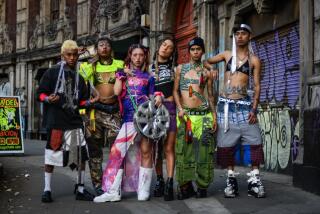Garden Grove Designer Walt Kendrick Knows Who His Homme Boyz Are
- Share via
For Garden Grove designer Walt Kendrick, seeing his Homme Boyz label on such celebrities as Patrick Ewing and Charles Oakley of the New York Knicks, Ron Harper of the Clippers and rappers Joe Cooley and Comptus Righteous doesn’t rank as the ultimate coup.
What Kendrick, 29, considers the high point was personally giving his signature red, white and blue ball caps to then-nominee Bill Clinton and the Rev. Jesse Jackson during their visit to South-Central Los Angeles following the riots in April 1992.
“Now that was cool,” he recalls.
And it wasn’t a bad way to kick off his first “true” collection, which premiered that same month in stores.
In the 17 months since then, Kendrick has seen his wares on other personalities, but his greatest pleasure, he says, is seeing it on regular folk, from his homies to strangers.
“We’re like the pop of street wear. I didn’t set out to reinvent the wheel,” he says. “Cross Coulors focuses on ethnicity, whereas GAT and 26 Red hit the other end of the spectrum. But I felt there was a void for a line that was a little more generic. I wanted to do something in between--but still not too mainstream.”
His silhouettes and T-shirt graphics are designed for the individual who appreciates the comfort and style of street wear--without the extremes. Items such as his shorts and pants hang on the hips and are not intended to make fashionable below-the-belt exposure.
Still, shapes fit loosely, and some are influenced by the oversize trend in street wear. The hooded coverall ($90) features very droopy drawers and large, deep drop pockets.
Creating a functional collection is foremost for Kendrick. “People are doing more and having less time to change their clothes. You got school or work, and afterward you want to be able to (play) ball right away. So the next wave for street wear is toward an athletic bent,” he predicts.
“On the court,” he adds jokingly, “if you don’t play good you gotta look good at least.”
Retailers are receptive to his message. Sporting goods stores, including Foot Locker, make up about half of his retail accounts.
That translates into using fabrics that can wear well regardless of abuse. Kendrick has also incorporated into the line a lighter fleece that looks like denim; besides keeping cooler, it won’t stick to sweaty skin the way denim does.
The collection pieces, which sell for $16 to $90, have also found success with relaxed fabrics such as flannels and wovens, as well as lightweight denim. Kendrick reflects his penchant for basics in his color palette and designs, with only subtle detailing.
Overstitching is done in a different color than the fabric, or solid-colored cotton is paired with plaid flannel. A popular result of that combination has been the black baseball jersey with flannel sleeves ($40), which has been popular among young women.
Although most of Homme Boyz market is young men, the label has experienced some sales crossover with women who have sought comfortable pieces such as the throw-over poncho with a kangaroo pocket ($49) and boxer-style short ($35). “A good item to (play) ball in,” Kendrick notes.
Though success with his entire collection encourages him to keep expanding the line, it’s no surprise to Kendrick that he gets his greatest strength in sales with his graphics-splashed T-shirts ($16). Among the biggest sellers: a cartoonish hand scratching a record, “Just Say Yo” and “Too Fly,” which is spelled out with the number two and a picture of a fly.
The latter two, as well as ones featuring the logo in various forms, also do well on ball caps ($19).
A self-described “product of screen printing,” Kendrick took his University of Wyoming art degree and moved to Fullerton in 1987. Wyoming is “not exactly a thriving creative mecca, so I had to move west,” he recalls.
He was a graphic designer for Crazy Shirts, a silk screener, and free-lanced for Vision Sports, a Tustin-based skateboard manufacturer. More than a year later, he went to work for another large screener, Rosenblatt & Sons in Los Angeles.
“That’s when I became more focused and decided to own my own company,” he says.
In 1989, he took the plunge, free-lancing to support himself while putting together a small line of T-shirts.
Over a period of two years, he developed the concept for Homme Boyz while seeking silent investors to back him. By April ’92 he had his company off the ground and in some of his favorite stores . . . and on some of his favorite people.
In addition to the store chains, Homme Boyz has cultivated a base at smaller specialty stores such as Zero Gravity in Newport Beach, Funky Revolution in Santa Ana, the Playground in South-Central, Modus on Melrose in Hollywood and Deep Threads in Oakland.
More to Read
The biggest entertainment stories
Get our big stories about Hollywood, film, television, music, arts, culture and more right in your inbox as soon as they publish.
You may occasionally receive promotional content from the Los Angeles Times.










